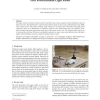107
Voted
CGF
2008
15 years 1 months ago
2008
This paper introduces a framebuffer level of detail algorithm for controlling the pixel workload in an interactive rendering application. Our basic strategy is to evaluate the sha...
115
Voted
CGF
2008
15 years 1 months ago
2008
This paper introduces an accurate real-time soft shadow algorithm that uses sample based visibility. Initially, we present a GPU-based alias-free hard shadow map algorithm that ty...
108
Voted
CGF
2008
15 years 1 months ago
2008
We present a novel representation and algorithm, ReduceM, for memory efficient ray tracing of large scenes. ReduceM exploits the connectivity between triangles in a mesh and decom...
97
Voted
CGF
2008
15 years 1 months ago
2008
The visibility function in direct illumination describes the binary visibility over a light source, e.g., an environment map. Intuitively, the visibility is often strongly correla...
103
Voted
CGF
2008
15 years 1 months ago
2008
This paper presents methods for photo-realistic rendering using strongly spatially variant illumination captured from real scenes. The illumination is captured along arbitrary pat...
79
Voted
CGF
2008
15 years 1 months ago
2008
We describe a rendering system that converts a 3D meshed model into the stylized 2D filled-region vector-art commonly found in clip-art libraries. To properly define filled region...
108
click to vote
CGF
2008
15 years 1 months ago
2008
Rendering animations of scenes with deformable objects, camera motion, and complex illumination, including indirect lighting and arbitrary shading, is a long-standing challenge. P...
140
click to vote
CGF
2008
15 years 1 months ago
2008
Thanks to an increase in rendering efficiency, indirect illumination has recently begun to be integrated in cinematic lighting design, an application where physical accuracy is le...
117
click to vote
CGF
2008
15 years 1 months ago
2008
This paper presents a novel method that effectively combines both control variates and importance sampling in a sequential Monte Carlo context. The radiance estimates computed dur...
110
click to vote
CGF
2008
15 years 1 months ago
2008
This paper presents a novel segmentation method to assist the rigging of articulated bodies. The method computes a coarse-to-fine hierarchy of segments ordered by the level of det...



